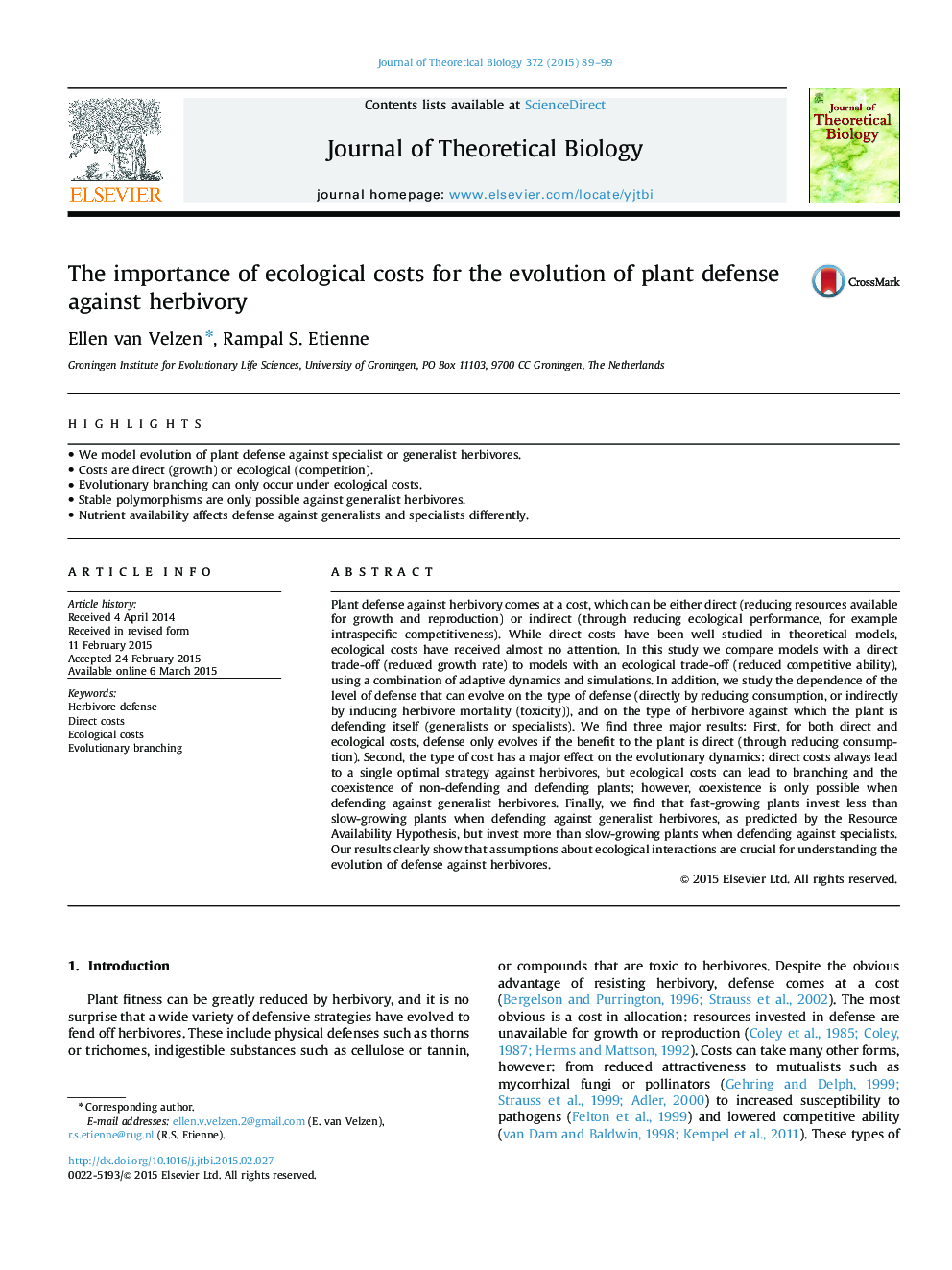| کد مقاله | کد نشریه | سال انتشار | مقاله انگلیسی | نسخه تمام متن |
|---|---|---|---|---|
| 6369815 | 1623838 | 2015 | 11 صفحه PDF | دانلود رایگان |
عنوان انگلیسی مقاله ISI
The importance of ecological costs for the evolution of plant defense against herbivory
ترجمه فارسی عنوان
اهمیت هزینه های زیست محیطی برای تکامل گیاهان دفاع از گیاهان
دانلود مقاله + سفارش ترجمه
دانلود مقاله ISI انگلیسی
رایگان برای ایرانیان
کلمات کلیدی
دفاع گیاهخوار هزینههای مستقیم، هزینه های زیست محیطی، انشعاب تکاملی،
ترجمه چکیده
دفاع گیاه در برابر گیاهان دارویی با هزینه ای مواجه می شود که می تواند به طور مستقیم (کاهش منابع موجود برای رشد و تکثیر) و یا غیر مستقیم (از طریق کاهش عملکرد اکولوژیکی، به عنوان مثال رقابت داخلی). در حالی که هزینه های مستقیم در مدل های نظری مورد مطالعه قرار گرفته اند، هزینه های زیست محیطی تقریبا هیچ توجهی را دریافت نکرده اند. در این مطالعه، مدل ها با مقایسه مستقیم (کاهش نرخ رشد) به مدل های با یک تجارت زیست محیطی (کاهش توان رقابتی)، با استفاده از ترکیبی از پویایی و شبیه سازی سازگار، مقایسه می شوند. علاوه بر این، وابستگی سطح دفاع را که می تواند به نوع دفاع (به طور مستقیم به وسیله کاهش مصرف یا به طور غیر مستقیم بوجود آمدن مرگ و میر گیاهخواران (سمیت)) و نوع گیاهخواری که علیه آن گیاه دفاع می کند، مطالعه می کند. (عمومی یا متخصص). ما سه نتیجه عمده را پیدا می کنیم: اول، برای هزینه های مستقیم و اکولوژیکی، دفاع تنها در صورتی پیش می رود که سود محصول به طور مستقیم (از طریق کاهش مصرف) باشد. دوم، نوع هزینه تاثیر عمده ای بر پویایی تکاملی دارد: هزینه های مستقیم همیشه به یک استراتژی مطلوب علیه گیاهخواران منجر می شود، اما هزینه های زیست محیطی می تواند منجر به انشعاب و همزیستی گیاهان غیر دفاع و دفاع شود؛ با این حال، همزیستی تنها زمانی امکان پذیر است که بتواند دفاع کند. در نهایت، ما دریافتیم که گیاهان سریع رشد می کنند در حالی که دفاع از علف کش های عمومی به عنوان پیش بینی شده توسط فرضیه منابع دسترسی، کمتر از گیاهان آهسته رشد می کنند، اما در دفاع از متخصصان، بیش از گیاهان آهسته رشد می کنند. نتایج ما به وضوح نشان می دهد که فرضیه های مربوط به تعاملات زیست محیطی برای درک تکامل دفاعی در برابر گیاهخواران حیاتی است.
موضوعات مرتبط
علوم زیستی و بیوفناوری
علوم کشاورزی و بیولوژیک
علوم کشاورزی و بیولوژیک (عمومی)
چکیده انگلیسی
Plant defense against herbivory comes at a cost, which can be either direct (reducing resources available for growth and reproduction) or indirect (through reducing ecological performance, for example intraspecific competitiveness). While direct costs have been well studied in theoretical models, ecological costs have received almost no attention. In this study we compare models with a direct trade-off (reduced growth rate) to models with an ecological trade-off (reduced competitive ability), using a combination of adaptive dynamics and simulations. In addition, we study the dependence of the level of defense that can evolve on the type of defense (directly by reducing consumption, or indirectly by inducing herbivore mortality (toxicity)), and on the type of herbivore against which the plant is defending itself (generalists or specialists). We find three major results: First, for both direct and ecological costs, defense only evolves if the benefit to the plant is direct (through reducing consumption). Second, the type of cost has a major effect on the evolutionary dynamics: direct costs always lead to a single optimal strategy against herbivores, but ecological costs can lead to branching and the coexistence of non-defending and defending plants; however, coexistence is only possible when defending against generalist herbivores. Finally, we find that fast-growing plants invest less than slow-growing plants when defending against generalist herbivores, as predicted by the Resource Availability Hypothesis, but invest more than slow-growing plants when defending against specialists. Our results clearly show that assumptions about ecological interactions are crucial for understanding the evolution of defense against herbivores.
ناشر
Database: Elsevier - ScienceDirect (ساینس دایرکت)
Journal: Journal of Theoretical Biology - Volume 372, 7 May 2015, Pages 89-99
Journal: Journal of Theoretical Biology - Volume 372, 7 May 2015, Pages 89-99
نویسندگان
Ellen van Velzen, Rampal S. Etienne,
